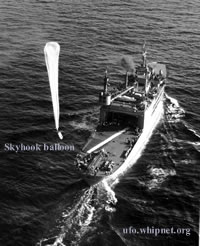|
LIFE Magazine, April 7, 1952
by H. B. Darrach Jr. and Robert Ginna
INCIDENT 9
On Jan. 29, 1952, just before midnight, a B-29 was on solo mission over Wonsan, Korea. It was flying at a speed somewhat less than 200 miles an hour, at an altitude somewhat above 20,000 feet. Simultaneously the tail gunner and the fire-control man in the waist saw a bright round orange object in the sky near the plane. Both said it was about three feet in diameter, flew with a revolving motion on a course parallel to theirs, and wore a halo of bluish flame. It also appeared to pulsate. The object followed the B-29 for about five minutes, then pulled ahead and shot away at a sharp angle. On the same night a similar globe was seen by the tail gunner and waist man of another B-29, 80 miles away over Sunchon, but flying at about the same height. The globe followed the plane for about a minute, then disappeared.
EVALUATION
Theoreticians in the Air Force believe the fireballs were not natural phenomena but propelled objects. They bear some similarity to the balls of fire called "fireball fighters" or "foo fighters" -- which flew wing on Allied aircraft over Germany and Japan during 1944-45 and which have never been satisfactorily explained. In the Korean incidents, the fireballs seem -- on the evidence of their sharp acceleration, their blue light and their abrupt, angular swerve -- to resemble the saucers described earlier.
The same disks sighted by Redman were seen by W.S. Morris, ex-Air Force master sergeant.
INCIDENT 10
On the night of Nov. 2, 1951 a ball of kelly-green fire, larger than the moon, and blazing several times more brightly, flashed eastward across the skies of Arizona. It raced, straight as a bullet, parallel to the ground, and then exploded in a frightful paroxysm of light --- without making a sound. At least 165 people saw the incredible thing; hundreds more witnessed the similar flight of countless other fireballs that since December 1948 have bathed the hills of the Southwest in their lunar glare. In the last year they have been seen as far afield as Pennsylvania, Maryland and Puerto Rico. The chief Air Intelligence officer for the Albuquerque district saw one. Colonel Joseph D. Caldara, USAF, attached to the Joint Chiefs of Staff, saw one in Virginia. Hundreds of pilots, weather observers and atomic scientists have sighted them. Reports came so thick and fast during 1948 that in 1949 the Air Force established "Project Twinkle" to investigate them. Project Twinkle established a triple Phototheodolite post at Vaughn, N. Mexico to obtain scientific data on the fireballs. Day and night, week in, week out, for three months, a crew kept vigil. Ironically, while fireballs continued flashing everywhere else in the Southwest, they saw nothing until the project was transferred to the Holloman Air Force Base at Alamogordo, N. Mexico There, during another three-month siege, they saw a few but were unable to make satisfactory computations because of the fireballs' great-speed. Search parties have had no better luck. They have combed in vain the countryside beneath the point of disappearance; not a trace of telltale substance has been found on the ground.
EVALUATION
The popular Southwest belief that a strange meteor shower was underway has been blasted by Dr. Lincoln La Paz, mathematician, astronomer and director of the Institute of Meteoritics at the University of New Mexico. He points out that normal fireballs do not appear green, they fall in the trajectory forced on them by gravity, are generally noisy as a freight train, and leave meteorites where they hit. The green New Mexican species does none of these things. Neither do the green fireballs appear to be electrostatic phenomena -- they move too regularly and too fast.
If the fireballs are the product of a U.S. weapons project, as some Southwesterners believe, it is a very secret one indeed: the Atomic Energy Commission and every other government agency connected with weapons development has denied to LIFE any responsibility for the fireballs.
Could they be self-destroying Russian reconnaissance devices? Not likely. While the U.S. believes the Russians have an intercontinental guided missile, there is no intelligence that indicates they have developed silent power plants or objects capable of moving nearly as fast as meteors (12 miles a second). Yet -- for whatever it may be worth -- the only reports of green fireballs prior to 1948 came from the Baltic area.
If the fireballs do not respond to gravity, they could only be explained as lighter-than-air craft or electrical phenomena -- but they have characteristics which rule these out. Therefore they must be propelled. If propelled and not natural phenomena, they must be artificial. The extreme greenness of the fireballs has impressed most witnesses. When asked to indicate the approximate color on a spectrum chart, most of them have touched the band at 5,200 angstroms, close to the green of burning copper. Copper is almost never found in meteorites; the friction of the air oxidizes it shortly after the meteor enters the upper atmosphere. However, a curious fact has been recorded by aerologists. Concentrations of copper particles are now present in the air of Arizona and New Mexico, particularly in "fireball areas." These were not encountered in air samples made before 1948.
WHAT THEY ARE NOT,
AND WHAT THEY MAY BE
What are the flying saucers, the luminous fuselages, the foo fighters and the green fireballs? The answer -- if any answer at this time is possible -- lies in the field of logic rather than of evidence. What the things are may be adduced partially by reviewing what they are not.
THEY ARE NOT PSYCHOLOGICAL PHENOMENA.
Although the Air Force cheerily wrote off its 34 unexplained incidents with this pat theory, the explanation does not hold up. There is no evidence, beyond textbook speculation, for such a supposition, and there is the direct evidence already cited against it. To doubt the observers in the foregoing cases is to doubt the ability of every human being to know a hawk from a handsaw.
THEY ARE NOT THE PRODUCT OF U.S. RESEARCH.
LIFE investigated this possibility to exhaustion. Not fully satisfied by the public denials of President Truman, Secretary Johnson and others, the investigators put the question directly to Gordon Dean, chairman of the Atomic Energy Commission. He said: "There's nothing in our shop that could account for these things, and there's nothing going on that I know of that could explain them." Still unconvinced, LIFE checked the whereabouts and present business of every scientist who might have anything to do with the development of super aircraft. All were accounted for in other ways. Careful feelers through the business and labor world encountered no submerged projects of the immensity necessary to build a fleet of flying disks. And there is still the conclusive fact: U.S. science has at its command no source of power that could put a flying machine through such paces as the saucers perform.
THEY ARE NOT A RUSSIAN DEVELOPMENT.
It is inconceivable that the Russians would risk the loss of such a precious military weapon by flying a saucer over enemy territory. No man-made machine is foolproof; sooner or later one would crash in the U.S. and the secret would be out. Nor is there any reason to believe that Russian science, even with German help, has moved beyond not only the practical but the THEORETICAL horizons of U.S. research.
THEY ARE NOT DISTORTIONS OF THE ATMOSPHERE RESULTING FROM
ATOMIC ACTIVITY.
To quote the answer David Lilienthal, former AEC commissioner, once made to that suggestion: "I can't prevent anyone from saying foolish things." Nor are they aberrations of the northern lights. Magnetic disturbances cannot account for them and neither can a notion (recently fathered by Dr. Urner Liddel, the Navy physicist) that they are "vertical mirages" -- reflections from a vertical (instead of a horizontal) layer of heated air.
THEY ARE NOT SKYHOOK BALLOONS.
This was the, original Liddel explanation, and in a few instances it may have been correct. But not many. They could scarcely be "fireflies in the cockpit," as one Air Force colonel suggested, since most of the observers were not in a cockpit when they saw their saucers. And it is hard to believe that saucers could be the reflections of automobile headlights on clouds, when they are seen in daylight under cloudless skies. These being the dead-end alleys of negative evidence, is there hope of an explanation on the open avenues of scientific theory? The answer is yes.
 |
The rank of science has taken the saucers far more seriously than the file of laymen and, after five years of close watch on all reports, a number of scientists were ready with some conclusions. One of these was Dr. Walther Riedel, once chief designer and research director at the German rocket center in Peenemunde, now engaged on secret work for the U.S. Dr. Riedel has never seen a saucer himself, but for several years he has kept records of saucer sightings all over the world. He told LIFE: "I am completely convinced that they have an out-of-world basis."
Dr. Riedel has four points to his argument: "First, the skin temperatures of structures operating under the observed conditions would make it impossible for any terrestrial structure to survive. The skin friction of the missile at those speeds at those altitudes would melt any metals or nonmetals available.
"Second, consider the high acceleration at which they fly and maneuver ... In some descriptions the beast spirals straight up. If you think of the fact that the centrifugal force in a few minutes of such a maneuver would press the crew against the outside, and do likewise to the blood, you see what I mean.
"Third... There are many occurrences where they have done things that only a pilot could perform but that no human pilot could stand.
"Fourth, in most of the reports there is a lack of visible jet. Most observers report units without visible flame ... and no trail. If it would be any known type of jet, rocket, piston engine, or chain-reaction motor, there would be a very clear trail at high altitude. It is from no power unit we know of ..."
Dr. Riedel's arguments are reinforced by those of Dr. Maurice A. Biot, one of the leading aerodynamicists in the U.S. and a prominent mathematical physicist. From an aero dynamical viewpoint, says Dr. Biot, the saucer shape makes very little sense if the machine is to travel in the atmosphere. A disk has a high drag and is a poor airfoil unless stabilized; when whirled at high speed through the air, it "wobbles" distressingly -- a movement observed in several of the saucers sighted. However, for space travel, where there is no atmosphere to oppose, the disk has significant advantages. The sphere, theoretically better, presents several difficult problems of construction and utilization. The disk, easier to build, has almost all the virtues of the sphere and some of its own. Reviewing the evidence presented here, Dr. Biot said: "The least improbable explanation is that these things are artificial and controlled ... My opinion for some time has been that they have an extraterrestrial origin."
WHO? WHAT? AND WHEN?
There, at least, is a plausible explanation of the disk shape. But the real depths of the saucer mystery bemuse penetration, as the night sky swallows up a flashlight beam. What of the other shapes? Why do the things make no sound? How to explain their eerie luminosity? What power urges them at such terrible speeds through the sky? Who, or what, is aboard? Where do they come from? Why are they here? What are the intentions of the beings who control them?
Before these awesome questions, science -- and mankind -- can yet only halt in wonder. Answers may come in a generation -- or tomorrow. Somewhere in the dark skies there may be those who know.
A U.S. rocket is launched from a proving ground. Neither this nor any known U.S. missiles fit the descriptions of the sighted saucers and fireballs.
Related:
Flying Triangle sightings on the rise
The Phoenix Lights - 1997
Peterborough, Ontario Triangular UFO Sighting
Page 1
Page 2
Page 3
Page 4
|

